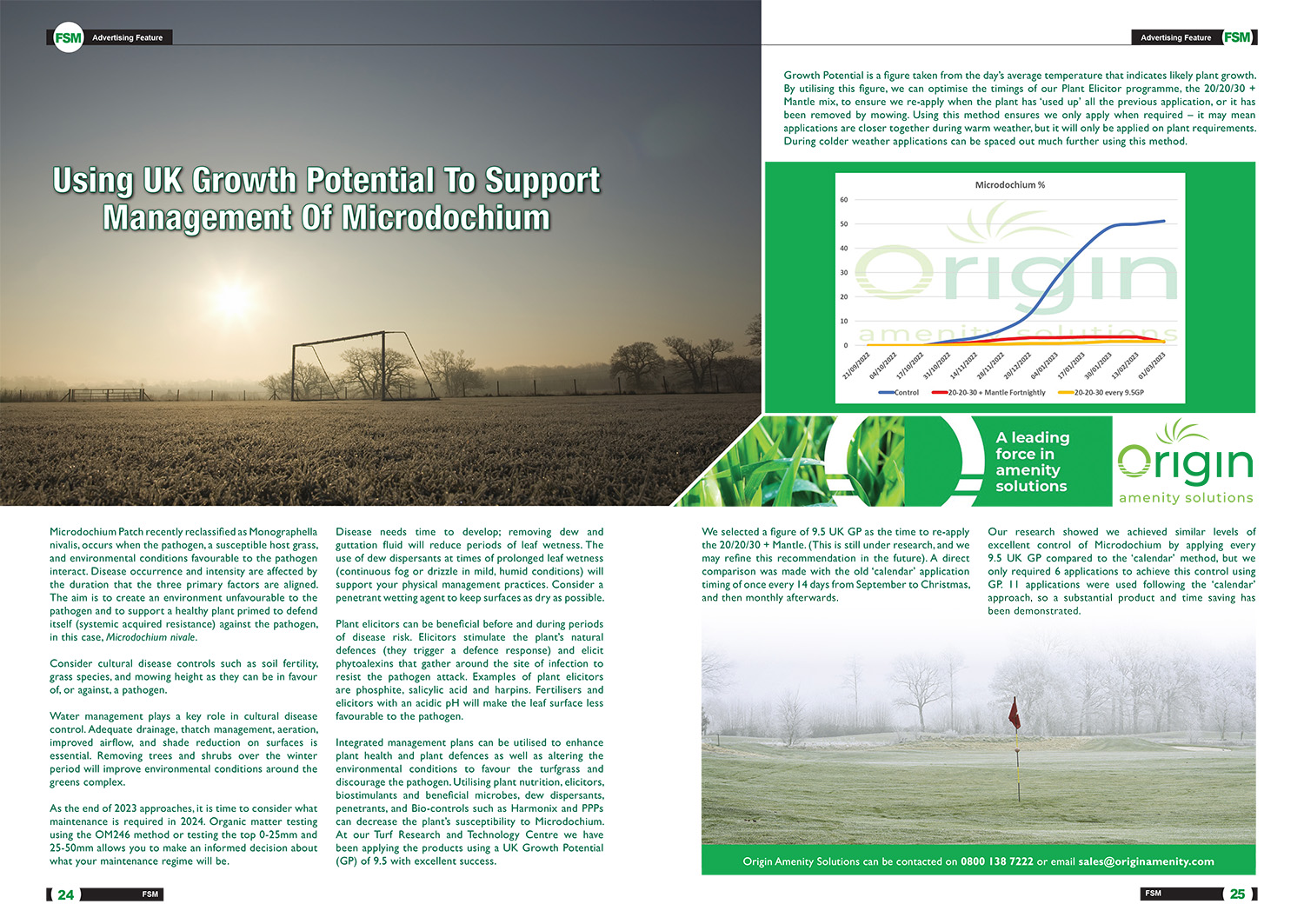Using UK Growth Potential To Support Management Of Microdochium

Microdochium Patch recently reclassified as Monographella nivalis, occurs when the pathogen, a susceptible host grass, and environmental conditions favourable to the pathogen interact. Disease occurrence and intensity are affected by the duration that the three primary factors are aligned. The aim is to create an environment unfavourable to the pathogen and to support a healthy plant primed to defend itself (systemic acquired resistance) against the pathogen, in this case, Microdochium nivale.
Consider cultural disease controls such as soil fertility, grass species, and mowing height as they can be in favour of, or against, a pathogen.
Water management plays a key role in cultural disease control. Adequate drainage, thatch management, aeration, improved airflow, and shade reduction on surfaces is essential. Removing trees and shrubs over the winter period will improve environmental conditions around the greens complex.
As the end of 2023 approaches, it is time to consider what maintenance is required in 2024. Organic matter testing using the OM246 method or testing the top 0‑25mm and 25‑50mm allows you to make an informed decision about what your maintenance regime will be.
Disease needs time to develop; removing dew and guttation fluid will reduce periods of leaf wetness. The use of dew dispersants at times of prolonged leaf wetness (continuous fog or drizzle in mild, humid conditions) will support your physical management practices. Consider a penetrant wetting agent to keep surfaces as dry as possible.
Plant elicitors can be beneficial before and during periods of disease risk. Elicitors stimulate the plant’s natural defences (they trigger a defence response) and elicit phytoalexins that gather around the site of infection to resist the pathogen attack. Examples of plant elicitors are phosphite, salicylic acid and harpins. Fertilisers and elicitors with an acidic pH will make the leaf surface less favourable to the pathogen.
Integrated management plans can be utilised to enhance plant health and plant defences as well as altering the environmental conditions to favour the turfgrass and discourage the pathogen. Utilising plant nutrition, elicitors, biostimulants and beneficial microbes, dew dispersants, penetrants, and Bio‑controls such as Harmonix and PPPs can decrease the plant’s susceptibility to Microdochium. At our Turf Research and Technology Centre we have been applying the products using a UK Growth Potential (GP) of 9.5 with excellent success.
Growth Potential is a figure taken from the day’s average temperature that indicates likely plant growth. By utilising this figure, we can optimise the timings of our Plant Elicitor programme, the 20/20/30 + Mantle mix, to ensure we re‑apply when the plant has ‘used up’ all the previous application, or it has been removed by mowing. Using this method ensures we only apply when required – it may mean applications are closer together during warm weather, but it will only be applied on plant requirements. During colder weather applications can be spaced out much further using this method.

We selected a figure of 9.5 UK GP as the time to re‑apply the 20/20/30 + Mantle. (This is still under research, and we may refine this recommendation in the future). A direct comparison was made with the old ‘calendar’ application timing of once every 14 days from September to Christmas, and then monthly afterwards.
Our research showed we achieved similar levels of excellent control of Microdochium by applying every 9.5 UK GP compared to the ‘calendar’ method, but we only required 6 applications to achieve this control using GP. 11 applications were used following the ‘calendar’ approach, so a substantial product and time saving has been demonstrated.
Origin Amenity Solutions can be contacted on 0800 138 7222 or email This email address is being protected from spambots. You need JavaScript enabled to view it..
Click the article to enlarge it.











































